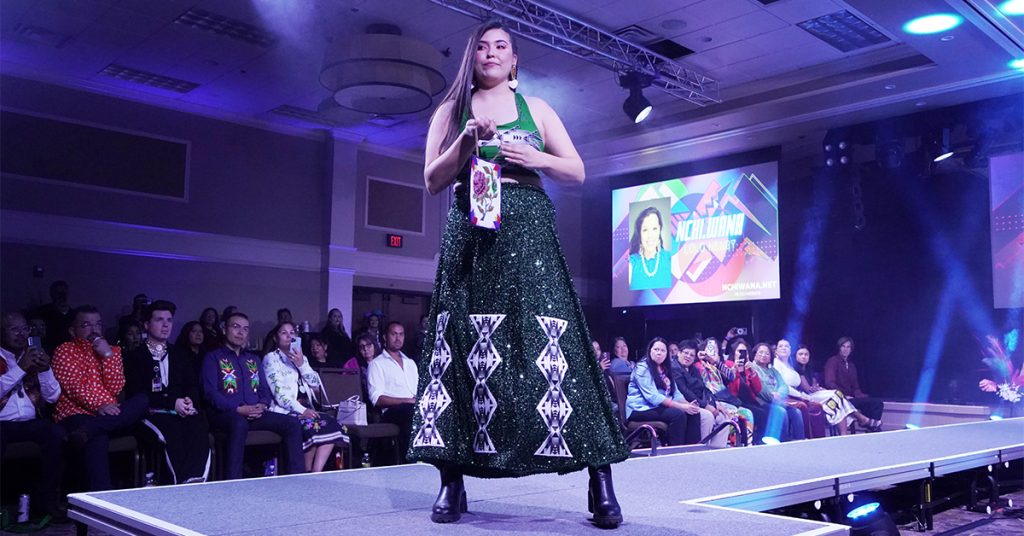BY NIKA BARTOO-SMITH
Underscore News
MISSION, Ore. — On the night of Oct. 4, a conference room at Wildhorse Resort & Casino on the Umatilla Indian Reservation transformed into a runway rivaling that of New York Fashion Week — with all Native models wearing Native-made designs.
Kicking off the second annual Northwest Native Fashion Show at the Northwest Native Economic Summit, a model wearing a lacy black cloak that obscured her face walked slowly down the runway, smudging the audience, as a video showing images of the earth played on a big screen in the background. Smoke filled the room and sounds of a storm cracked through the air as a projected voice introduced this year’s theme, “Revolvelution.”
While some might call the 13 Native designers at this year’s show “emerging designers,” summit and fashion show co-organizer Casey Pearlman, Iñupiaq, clarified that many of these women have been making clothing for family and friends for years. Speaking of designer Dorothy Cyr, Pearlman said, “It’s not her that’s emerging, it’s support for her that’s emerging.”
Growing up seeing his family sew works of art, Jacob Wallis knew he wanted to bring his mom and aunties the recognition, and economic opportunities, for the beautiful designs they create.
Wallis, business services manager at Nixyaawii Community Financial Services, teamed up with Pearlman to launch the Northwest Native Fashion Show, a collaboration between Nixyaawii Community Financial Services and the Affiliated Tribes of Northwest Indians Economic Development Corporation (ATNI-EDC).
“This isn’t just about showcasing, it’s about creating generational wealth within our communities,” Wallis, Umatilla, Yakama and Niimiipuu, said during an intermission. “So get out those credit cards.”
After the show, a handful of audience members rushed backstage to purchase showcased pieces as the models hung them back on the racks.
Not only does the fashion show provide a space for the designers to showcase their work, but Wallis also connects them with marketing support at Wildhorse, helps them create a business strategy and provides a place to sell their work at Hamley Western Store in downtown Pendleton, Oregon. In 2019, the Confederated Tribes of Umatilla bought the iconic western wear store, which was founded in 1883.
It’s all part of a strategy to build economic prosperity among tribal members.
“We’re no longer at the kitchen table,” Wallis said. “Kitchen table implies side hustle, and we’re done with that. I want creatives to be creatives and have the experience of being creative only. We’re done with the nine-to-five.”
What started as a relatively small fashion show last year, with around 75 attendees, has since grown, with nearly 300 people in the audience this year.
The show also highlighted more designers and more signature pieces. While each designer had a unique style, outfits mixing traditional Native style and modern design were common.
“It’s storytelling in motion,” said Pearlman, director of business and development at ATNI-EDC, who co-organized the summit and fashion show with Wallis. “People put their whole hearts out there.” (Disclosure: Pearlman is treasurer of Underscore’s Board of Directors).
Of this year’s 13 Native designers, the majority were Nez Perce and Confederated Tribes of Umatilla Indian Reservation tribal members. Spring Alaska Schreiner, Chugach Alaska Native Corporation and Valdez Native Tribe, was the exception. And both Pearlman and Wallis said they hope to see the fashion show continue to expand to include Native designers from all across the Northwest.
Schreiner entered the fashion show as both a designer and model this year — carrying one of the angora and leather bags made by Gia Paul. Schreiner’s own work is primarily made using leather and otter pelts.
“Tribal fashion is food sovereignty,” Schreiner said after the show.
“We’re looking at everything,” Wallis added. “We’re looking at the hide, the meat. Looking at what these animals do for us and how do we create economic prosperity through that.”
‘The belle of the ball’
Paula Wallis grew up on the Umatilla Indian Reservation, where she learned to sew from her mom and aunties. Her family bought most of her clothes at second hand stores and altered them to make them unique.
“I had one-of-a-kind outfits,” Wallis said. “I felt like the belle of the ball.”
At 10, she began traveling around the country with her cousin, Native fashion designer Vivian Peters. Wallis modeled Peters’ work.
“All throughout the west she was known,” Wallis said. “She was an amazing seamstress and I was lucky enough to learn from her.”
Inspired by her cousin, aunties and mom, Wallis has been sewing her whole life. Her designs range from regalia and streetwear for herself to homemade Halloween costumes for all six of her children.
Wallis made her debut as a designer last year, during the fashion show her son organized.
At the 2022 Northwest Native Fashion Show, Jacob Wallis invited his mom and an aunt to participate. Paula Wallis ended up making jewelry to adorn her sister’s clothing designs.
This year, Wallis was back, with her own full collection on display.
Her signature pieces blend traditional Native designs with upcycled clothing, found at second hand stores during her travels across the country. As she explored the fashion industry, Wallis learned about the harm fast fashion has on the environment. Her solution is to reuse items already out in the world.
Last month, Hamley Western Store displayed the work of both Wallis and her sister, Tricia Hilliard, as featured Northwest Native American Designers.
Now, Wallis gets to return the gift the women in her family bestowed upon her by helping other young women get to feel like the “belle of the ball” while wearing her upcycled pieces.
“My mama and my aunts taught me that, when you make something, it’s not meant to sit in the closet. It’s meant to be worn, it’s meant to be loved and it’s meant to be noticed,” Wallis said. “And you’re to be noticed when you wear it.”
One of the models was Wallis’ daughter, Rachel Wallis. Braids wrapped in otter pelts flowed down her back, nearly touching the floor. She wore long, white otter earrings that stood out against her black shirt and pants. On her feet were a pair of calf length moccasins with red, yellow and purple stitching. Her look showcased the traditional.
Another model wore a silk purple shirt, turquoise jewelry and a black hat with a blue band and feathers — a mix of traditional and modern elements.
Jacob Wallis wants everyone to feel comfortable wearing fashions designed by Indigenous people.
“Cultural appropriation is very much a thing,” Wallis said. “But I also think Native people selling their products as is, that’s not cultural appropriation, that’s cultural celebration. And we need to understand the difference.”
‘If you can wear it, I can make it’
Last year, Wetalu (Lulu) Henry, participated as a designer in her first ever fashion show at the Northwest Native Fashion Show. A year later, she has quit her day job to design and sell clothes full time.
“If you can wear it, I can make it,” Henry said.
Henry, Niimiipuu and Warm Springs, describes her style as neotraditional — many of her pieces include vivid colors and geometric design, mixing traditional designs with modern style.
Henry mostly sells her work through her online store, ‘Nchi.wana, where she sells t-shirts, hats, stickers, earrings and custom order powwow regalia.
Like several other designers featured in this year’s fashion show, powwow regalia is where it all began for Henry. Growing up, she learned to make her own regalia from her mom and watched as her mother made some extra income making regalia for other people.
Inspired by her mother’s entrepreneurship, Henry had a side hustle selling beaded earrings while she was in college. She earned her bachelor’s degree in psychology.
Last year, while participating in the Northwest Native Fashion Show, Henry built a roadmap for her business. When designers begin to prepare for the fashion show, Jacob Wallis helps them to build a business plan and set up some of the essentials, such as a logo and business cards.
Henry also took classes through the Niimiipuu Fund to learn about how to be a small business owner. Now, she is one.
At this year’s fashion show, Henry displayed 11 different outfits. Her looks included jean jackets with patches of Niimiipuu warriors, a purple ribbon mini dress, and a pink cowgirl hat adorned with ribbons, feathers and the words “Land Back.”
Perhaps her most striking design was a two-piece, mustard yellow outfit. Ribbons lined the hem of the skirt and the ends of the sleeves. Stars traveled from across the model’s back to the edge of her skirt where they formed the big dipper. A suplis symbol is stitched above the hem of the skirt, used to denote the changing of the seasons, rotating like the big dipper in the sky.
“The suplis is the whirlwind that most people who are not Native mistake it for the Nazi sign,” Henry said. “But in our culture it represents the changing of the seasons.”
The name of her business, ‘Nchi.wana, means “the big river” in Sahaptin — the language spoken by the Warm Springs bands who traditionally lived along the Columbia river tributaries. The big river refers to the mid-Columbia river and in naming her business after the river, Henry is acknowledging her ancestor’s connection to the area.
“[The name] honors the fishermen in my family who fished the Columbia River,” Henry said. “It is to pay homage with the name.”
‘Connection with my ancestors’
Last year, longtime educator Gia Paul, Nez Perce, decided she wanted to try something new. Looking forward to the Niimiipuu Indigenous Fashion Show, she committed to learn how to make chaps — her work would be in the show.
She made not only her first pair of chaps, but a total of five. One to honor each of her uncles who rode broncos and one to honor her mother.
“They’ve all passed away, but I wanted to honor them,” Paul said. “[My uncles] are all champions. And if you know anything about horse culture, there’s always a caretaker, and that was my mother.”
Unbeknownst to Paul, the market producer for Hamley Western Store attended the fashion show. Afterward, he approached Paul and soon she signed a contract to sell her chaps there.
“I’ve been coming to Hamley’s as a customer for over 20 years. So to have my actual chaps and chinks inside their store is just over the top,” Paul said.
Paul has been sewing since she was a child, starting out by making clothes for her Barbie dolls. That soon progressed to clothes for herself as well as powwow regalia, in a sewing circle with her mom and aunties.
Now, Paul dedicates a few hours most days to sew chaps and powwow regalia – on top of her full-time job as a teaching assistant. Her sewing machine is set up outside so she can breathe in fresh air and connect with nature while working.
“It’s actually my happy place,” Paul said. “If I’m not in my classroom, I prefer to be in front of my sewing machine.”
Strutting down the runway on Wednesday night, models proudly showcased Paul’s work — five pairs of chaps, four cross-body bags made out of leftover angora and leather scraps and a multi-colored shawl adorned with horses, each with a neon green mane.
Inside each pair of chaps, Paul hand-painted the same image — her mother riding a bronco. “I always try to make a connection with my ancestors,” Paul said.




